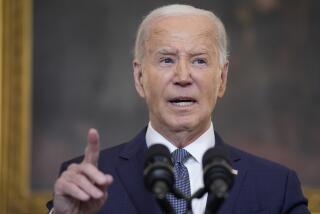Tamil Rebels May Give Up Their Arms
- Share via
COLOMBO, Sri Lanka — The leader of the Tamil Tigers returned to his rebel stronghold on the northern tip of this island nation Sunday amid reports that he has agreed to surrender his guerrilla group’s weapons in exchange for a political position in a newly created majority Tamil province.
Velupillai Prabhakaran, commander in chief of the Liberation Tigers of Tamil Eelam, the main fighting organization in the five-year separatist campaign against Sri Lankan government forces, was flown from India to Jaffna on the northern peninsula of the island in an Indian air force jet.
“He’s back and he will surrender his arms,” said one obviously pleased senior Sri Lanka official. However, the official cautioned that a weapons return is likely to be a symbolic act by the leader that may have to be followed by house-to-house searches for other arms, which range from barrels of plastic explosives to anti-aircraft weapons.
Meanwhile, the leader of another, smaller Tamil rebel group, the Eelam Revolutionary Organization, told reporters in Madras, India, that Prabhakaran has agreed to disarm in exchange for becoming chief minister, the senior political official in a new majority Tamil province that is to be created in the north and northeast areas of the island.
Told by Prabhakaran
Eelam Revolutionary Organization leader Velupillai Balakumar said he was informed of the arrangement by Prabhakaran himself, when the latter stopped in Madras on his way back to Jaffna.
However, the political deal was vehemently denied by Sri Lanka’s national security minister, Lalith Atulathmudali, a key figure in the government. “To make him chief minister is impossible,” Atulathmudali said.
For the last 10 days, Prabhakaran has been meeting with senior Indian officials--including Prime Minister Rajiv Gandhi--who have been urging him to accept the terms of a peace agreement signed Wednesday by Gandhi and President Junius R. Jayewardene of Sri Lanka.
Prabhakaran’s approval is critical to successful implementation of the agreement, which calls for the Liberation Tigers to surrender their weapons in exchange for the creation of a majority Tamil province. Without his order, Tiger commanders told Indian officers this weekend, they would not give up a single handgun.
“They are waiting for the word from their leader,” said Maj. Gen. Harkirat Singh, commander of the brigade of 3,000 Indian Army troops now deployed in the Jaffna Peninsula to supervise a cease-fire that went into effect Friday.
The agreement set a deadline of this afternoon for the estimated 5,000 Tamil guerrillas to give up their weapons. Indian and Sri Lankan Red Cross officials are supposed to supervise the process.
However, Indian diplomats and government officials said the deadline is likely to be extended. “It (the arms surrender) will take place within a reasonable time frame,” Indian Ambassador J. N. Dixit said Sunday. “This kind of thing cannot be put in a strait-jacket of time.”
Atulathmudali said that the surrender of weapons will commence at mid-afternoon today and continue for five days afterward.
Curfew Eased
Meanwhile, a nationwide curfew was being gradually eased Sunday as violent demonstrations by opponents of the peace agreement subsided. Sunday was the first time the curfew had been lifted for all daylight hours since more than 60 people were killed and millions of dollars worth of property was damaged in anti-government riots beginning Tuesday.
Most of the violence was directed against government officials and government-owned buildings and vehicles, including more than 300 buses that were destroyed. However, there were scattered instances of attacks by Sinhalese-majority mobs on the Tamil minority population.
On Sunday, four people were reported killed and 22 homes destroyed in the tea-growing area near Newara Eliya, where Tamils work picking tea leaves.
In Pandura, a city of 140,000 population 20 miles south of Colombo, reporters saw widespread damage. Several miles of power poles and lines had been toppled by protesters, and one school had been burned to the ground.
The walls of the city were plastered with posters of the radical, banned JVP (People’s Liberation Front) that mocked the peace agreement as a surrender of Sri Lanka sovereignty to India.
“From today, Sri Lanka is under control of the Indian government,” said one poster.
In another important related development, the leaders of the two most important Buddhist sects, Malwatte and Asgiriya, called for peace among the majority Sinhalese population. Out of Sri Lanka’s 16 million population, about 73% are Sinhalese, the majority of whom are Buddhists. About 13% of the population is Tamil, who are predominantly Hindu.
“The lack of opportunity to acquire a clear understanding regarding the facts of the recent accord between President Jayewardene and Prime Minister Rajiv Gandhi led to the campaign of nonviolent protest against it,” said a spokesman for the Asgiriya sect.
“However, it is now evident that certain other sinister and undisciplined elements have started committing acts of violence and provocation as well.”
More to Read
Sign up for Essential California
The most important California stories and recommendations in your inbox every morning.
You may occasionally receive promotional content from the Los Angeles Times.










